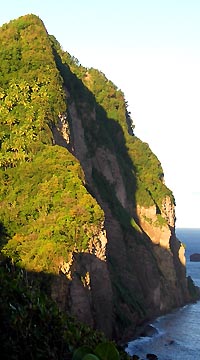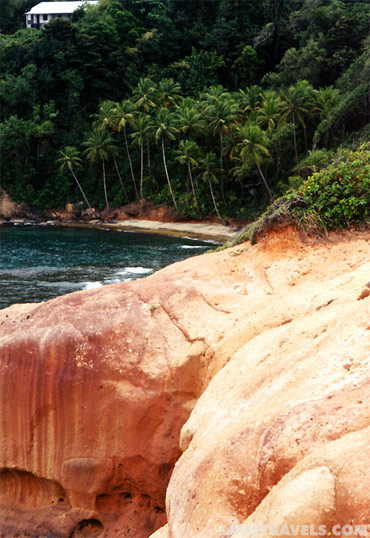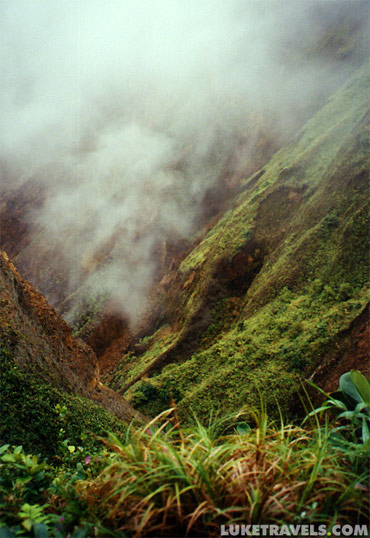Welcome
to the Island of Dominica -
LukeTravels.comô
Main Page
 Dominica Photo Gallery
Dominica Photo Gallery
 About the Island of Dominica
About the Island of Dominica
 Journey to the Boiling Lake
Journey to the Boiling Lake
 How to get to Dominica
How to get to Dominica
 Map of the Island
Map of the Island
 Airfare & Hotel Info
Airfare & Hotel Info
 Contact
Us
Contact
Us  Advertise
Here
Advertise
Here  Neighboring Island:
Guadeloupe
Neighboring Island:
Guadeloupe
 Neighboring
Island: Saint Lucia
Neighboring
Island: Saint Lucia
 LukeTravels.com Home
Page
LukeTravels.com Home
Page
DOMINICA -
THE NATURE ISLE
 |
 |
When it came to describing
the island of Dominica, Columbus was lost for words. He had just
returned from a second voyage to the New World and was trying to give
the king and queen an account of an archipelago that would be called
the West Indies. Eventually, so the story goes, he took a piece of
paper, crumpled it, and tossed it onto the table. "That is Dominica,"
he said. Approaching the
island five hundred years later - from an
American Eagle turbo-prop enroute from San Juan, Puerto Rico, rather than beneath the painted sails of a Spanish caravel -
Dominica is
still a dramatic place.
I can see why Columbus had to
improvise. These are the highest mountains in the Lesser Antilles.
They rise sheer out of the water like the back plates of a
stegosaurus. Their ridges and ravines, steeps and drop-offs make
volcanoes of other neighboring islands look prepubescent. |
There are curtains of rain shifting between the peaks - a
phenomenon that will characterize the days to come, and a flotilla of rainbows. Even from
several miles out at sea, Dominica has a magnetic energy, as if the island can't or won't
lie still.
Half a mile inland the arid belt of the western coast gives
way to what's plastered on the billboards: "Dominica, Nature Island of the
Caribbean." Suddenly everything is covered in vegetation, from the hillsides to
broken-down cars to backyards. Tree ferns grow by the roadside like props for Jurassic
Park, strangler figs are busy enveloping anything they can get hold of, and epiphytes -
orchids, ferns, Spanish moss - dangle from he branches of citrus trees. The air here is so
thick and warm you could gather it up in handfuls. It smells of ozone, like a greenhouse.
The Imperial Road is misleadingly named, and it is not long
before we are spinning around single-lane, hairpin bends like drivers at Le Mans. On
either side, towering into the cloud base, rise Dominica's mountain peaks Morne Trois
Pitons, Morne Counronne, Morne Fraser, Morne Diablotin (Dominica's highest, at 4,747
feet), Mang Peak, Mosquito Mountain - names that flip between English and French as
casually as did the sovereignty of Dominica in colonial times.
The fact that this is the main trunk road to the
international airport makes it easy to see that geography is king of the island. This
terrain proved impenetrable for centuries. It provided the Caribs, the people who once
inhabited the Winward Islands, with a last bastion against the invasion of Europeans. In
the late 1700s, it was a refuge for bands of escaped African slaves called maroons.

Photo Copyright © LukeTravels.com
|
 |
  |
Driving through the village of Riversdale, we
pass by one of their hideouts, Morne Negres Marrons. As recently as the 1970s,
a gang of "dreads" holed up here - black power fanatics raising
havoc on the island. But these are happier times. The presence of the
mountains, as we drive between them, is brooding and impressive but not
sinister. The interior of Dominica is no longer a place for outlaws. Now it is
famous simply for its beauty, and for nurturing one of the last oceanic rain
forests in the world, a rain forest that seems ready to engulf the road.
"Pointe Baptiste?" I ask a passing woman when I
emerge on the island's Windward side, slightly dizzy from the exertions of the interior.
She is one of a procession of people on their way to Sunday mass and is wearing a fine
gray bouffant wig, topped with a black pillbox hat and veil. She carries a patent leather
black handbag over one arm and clasps a pile of hymnbooks to her bosom. "Jes' follow
the pink house," she says "and turn right before you get to Calibishie."
Her directions puzzle me, until I catch up with a slow-moving convoy weaving its way up
through the banana plantations. Up at the front, like a party float leading the carnival,
is a pink house on the back of a trailer. There are people hanging out of its windows,
yelling; children running alongside; irate drivers tooting their horns - a riotous
all-singing, all-dancing cavalcade that marches me right up to the turnoff for Pointe
Baptiste.

Photo Copyright © LukeTravels.com
|
 |
  |
Half and hour down the coast from Pointe
Baptiste, in the
Carib reserve I find a man less resigned to the forces of oblivion. It is ten in the
morning, we are sitting in the shade of a mango tree, Fredrick is already half drunk.
"While there's one drop of Carib blood in me," he rails, "I will call
myself a Carib." I wouldn't dare draw attention to it, but there's more than a little
of Africa in him. The process of cultural surrender is well under way. Of the remaining
3,000 Carib descendants on the island, not many still have the straight hair of their
ancestors.
| The Caribs, seafaring invaders from South America, were
here when Columbus arrived. To them the island was Wai'tukubuli - "tall is her
body." Guns and disease swiftly got the better of the Caribs, but in Dominica they
could live as guerillas and still forage enough food to survive. Eventually, though, the
tribe was down to only 400 people, and the British felt the time had come to be
magnanimous. The empire granted them a small reserve on the island's windblown Atlantic
coast. Today the Carib village looks like any other on the island. |
|
|
"It's difficult to keep yourself Carib," says
Fredrick, his voice faltering in confusion, "when you need other things, when you go
to shops and bars." Only the Catholic churches in Carib territory are unusual. The
altars are made out of traditional gommier-wood canoes, and on the walls are murals of the
sea and stars and half-forgotten Carib legends, all painted by Fredrick himself. Fredrick
was lamenting the losses: "We have French patois on the radio; why can't we have
Carib? What hope is there for our culture if our children can't listen to the
language?" Would he say something for me in Carib? Fredrick thinks for a moment, then
answers with a few words. "What does that mean?" I ask. "Let's go
fishing," he says. And how many people would understand him? "Maybe then,"
he says. Fredrick looks uselessly at his hands as if they might suggest an answer
"Faustu-boy, what can we do?" On my way home I stop at a cafe' where a Carib
cultural group is performing for a busload of French tourists. The Caribs are dressed like
a cross between cowboys and Indians; their yellow cotton loincloths are trimmed with nylon
fringe. Underneath they're wearing Lycra bicycling shorts. Most of their songs are
calypsos.



